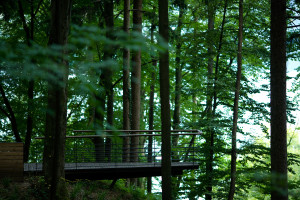by: Claire Webb
Ana Kučan, professor of Landscape Architecture at the University of Ljubljana, Slovenia, and founder of Studio AKKA, is deeply involved in mixing theory and practice, using an abstract framework as a leaping-off point for conceptualizing physical landscapes. At the Center for Architecture on 04.09.14, she provided the audience with a rich theory base, and then described actual projects that encompassed those ideas. Her talk, in celebration of Landscape Architecture Month, was part of the AIANY Architecture Dialogue Committee’s “Beyond New York” series.
For Kučan, untangling how humans “play” is the starting point for her design process. She argued that play and nature are deeply related, tracing back that linkage to its fundamental level. For some, nature is the model imperative, embodying “the beautiful”; others see its flipside – the sublime – and so for them, nature must be carefully controlled and sterilized to be appreciated. But for her, constructed landscapes, like a garden, a rambling vista, or a park, are manifestations of sometimes unconscious human tendencies to control or to let loose.
Kučan sees play as an essential lens through which to tease out this tension. As humans construct games in different landscapes, the physical limitations and pleasures of each space rise to the surface more quickly. How we shape, use, construct, and discard space can be mediated by how we play in that landscape – play “allows for uncertainties and challenges.” She sites Calder as a master of identifying this catalyst: his play circuses are monumental human dramas focused on a small scale that speak to “how we use space.” Moving into more usable settings, Kučan mused that play leads to “the dialectics of the polis.” Play can act as the slippage between “what’s allowed” and what’s not, therefore helping a group sort out power dynamics and social systems.
To Kučan, a byproduct of controlling nature more and more has led to a backlash where it now “seems like we have to create nature in order to preserve it.” As a landscape architect seeking to create “natural” spaces that amplify an “organic” feeling, how much should she show her hand? Could the decision to “not do” be a creative act, too? Because “the aesthetic and the ethical are inseparable” for her, this can be a tricky balance. Kučan’s theory-laden ideas about play transcend the abstract realm fluidly, and are vibrant in the projects she showed.
Kučan understands the site as more than physical: cultural, geographical, and social contexts must be taken into account, too. For a “School in the Woods” in Kočevje, she created a series of outdoor rooms where the visual landscape unfolds as the user moves through the space. The borders of the areas are “distinct but not exclusive,” allowing for fluidity of experience and, of course, play.
For a renovation of a villa in Bled, the landscape orients itself to views of an island in the middle of a glacial lake. Kučan’s design capitalized on the remnants of former structures. She cut away trees to get better views, creating sequential experiences as the residents explore and play in the reconstituted landscape.
One of Kučan’s bolder proposals (which was not, in the end, implemented) connected two little towns in Slovenia, Kranj and Kovka, over a ravine. The design hinged on allowing the canyon to continue to be a muscular presence, contrasting with the existing utilitarian ideology that simply ignored the surrounding nature. The “suture” between the populated areas and the canyon further heightened the aesthetic distinction between the insular, medieval towns and the green, wild ravine.
Designing the town beach at Izola was a project that Kučan seemed especially fond of: the beach was the only unbuilt site at sea level on Slovenia’s small coastline. By connecting the beach to the dark shelter of the pine trees, she created a patchwork of unusual views in a craggy, mountainous country to the beach’s “almost unbearable horizontality.” The design explored heady contrasts of light-dark and open-closed areas.
The largest project that Kučan showed was the Sports Park in Ljubljana that combined three buildings with gently sloping green space. Because the site was next to a highway, green relief was greatly needed. She placed a public park on top of the roof of the shopping center, creating two types of movements – rapid and purposeful, but also slow and meandering. The wind continues to exist as a very present element, and not one that is normally associated with constructed landscape architecture.
Kučan closed her talk by presenting the exhibit “All Shades of Green,” that was part of the Venice Biennale in 2010. She directly engaged the viewers, taking them through her design process,,all the while sprinkling in the driving theory of “play as design.”
Far from coming off as dense and academic, Kučan’s talk used theory muscularly, implementing it boldly to create powerful landscaped spaces. The breadth of her work – public parks, schools, beaches – speaks to the fact that “play as design” is a robust yet malleable conceptual starting point for sculpting a landscape.
Claire Webb studied astronomy and philosophy at Vassar College, but an interest in art history and architecture led her to the position of Marketing Director at Edelman Sultan Knox Wood / Architects.
Event: BEYOND NEW YORK: Playscape as Landscape – Joining Natural and Human Needs to Make Urban Space
Location: Center for Architecture, 04.09.14
Speaker: Ana Kučan, Professor of Landscape Architecture, University of Llubljana, Slovenia
Organizers: AIANY Architecture Dialogue Committee
Co-sponsors: ASLA-NY








